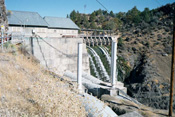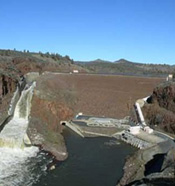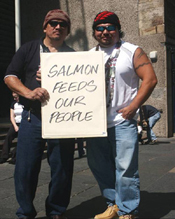Klamath Hydroelectric Project
The Operating License for the Klamath Hydroelectric Project (KHP) expired in March 2006 and the Federal Energy Regulatory Commission (FERC) is currently granting annual extensions for operation. The Native Americans of the Klamath Basin want the KHP dams removed since they block salmon access to hundreds of miles of habitat and they diminish salmon supply to the Klamath Tribes of Oregon and downstream Lower Klamath Basin Tribes. The KHP reservoirs degrade Klamath River water quality and create conditions favorable for fish disease epidemics. There is also emerging evidence that the lowest two reservoirs, Copco and Iron Gate, are increasingly dominated by toxic algae that threaten recreational and ceremonial uses of the Lower Klamath River (link to New Science).
Despite overwhelming scientific evidence of harm caused by KHP reservoirs and almost universal opposition from federal and State agencies to their remaining, the Federal Energy Regulatory Commission (FERC) in its Final Environmental Impact Statement recommends that KHP dams be granted a new 50-year federal license.
Klamath River Basin stakeholders negotiated the Klamath Hydroelectric Settlement Agreement (KHSA) that lays out the steps and criteria for removing the lower four Klamath River dams. More than 50 organizations were involved in the negotiations, including federal agencies, California and Oregon, Tribes, counties, irrigators and conservation and fishing groups. Some Consortium member Tribes support the KHSA and the associated Klamath Basin Restoration Agreement (KBRA) and some oppose it. The KHSA and KBRA are currently undergoing environmental analyses and awaiting congressional authorization/appropriation. More information on these agreements is available on the federal government's Klamath Restoration page.
This site contains comprehensive background information on the KHP that includes Tribal, conservation organization, California and Oregon agency and federal agency studies and comments. Information on KHP relicensing is organized as follows:
Location: The location of the Klamath Hydroelectric Project has a great deal to do with problems that it causes for water quality and fish. High nutrient loads from Upper Klamath Lake and the Lost River fuel prolific blooms of toxic blue-green algae in the stagnant waters of KHP reservoirs.
The Project: Each dam and reservoir within the KHP is described and depicted. Comments from agencies and participants in the relicensing process are highlighted so that issues such as fish passage, water quality and power generation can be reviewed quickly.
KHP Impacts on Water Quality: The Klamath River is officially listed as a polluted water body. Its water quality is driven by dozens of natural and man-made factors, including processes that happen in KHP reservoirs. Find out why the removal of KHP dams would help improve Klamath River water quality.
Fish Diseases: The Klamath River is world famous for salmon and steelhead fishing, but the river has become so unhealthy that sensitive species, like spring chinook, are at risk of extinction. Find out how KHP operation is linked to fish disease epidemics that are contributing to the salmon population crash. The shortage of Klamath salmon lead to major reductions and closures of 2006 commercial and sport salmon fisheries along the entire West Coast, resulting in a loss of an estimated $150 million to the region's economy.
A Note on Social Justice
The Tribes of the Klamath River Basin were promised hunting and fishing rights in perpetuity as part of the treaties they signed, but scarcity of salmon is a major indicator that the Tribe's rights are not being honored. Recent studies have shown that lack of salmon for subsistence has negative impacts on Indian health (see Study). Although FERC stresses the importance of maintaining the electricity produced by the KHP, many down-river Klamath River Tribal members live in areas not served by any power grid.
The continued operation of the KHP, with its attendant pollution and adverse effects on fish, is a grave injustice to the Tribes. Another 50 years of KHP operation would threaten Native salmon-based traditions that are more than 10,000 years old.



